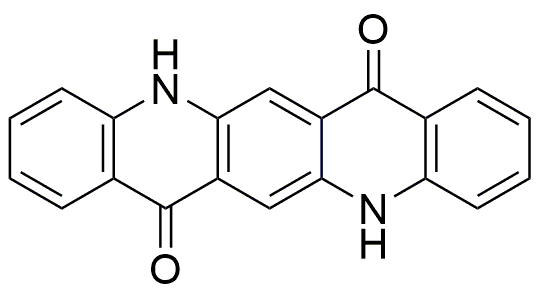Quinacridone is widely utilized in research focused on:
- Pigment Production: This compound is a key ingredient in high-performance pigments used in paints, coatings, and plastics. Its vibrant colors and excellent lightfastness make it ideal for outdoor applications.
- Ink Formulations: Quinacridone is commonly used in the production of inks for printing and packaging. Its stability and color intensity enhance the quality of printed materials.
- Organic Electronics: In the field of organic semiconductors, this chemical serves as a crucial component in organic photovoltaic cells and organic light-emitting diodes (OLEDs), contributing to the development of efficient electronic devices.
- Biomedical Applications: Quinacridone derivatives are being explored for use in drug delivery systems and as imaging agents in medical diagnostics, owing to their biocompatibility and ability to absorb specific wavelengths of light.
- Research in Material Science: The compound is utilized in the synthesis of advanced materials, including nanocomposites and conductive polymers, which are essential for developing new technologies in various industries.
General Information
Properties
Safety and Regulations
Applications
Quinacridone is widely utilized in research focused on:
- Pigment Production: This compound is a key ingredient in high-performance pigments used in paints, coatings, and plastics. Its vibrant colors and excellent lightfastness make it ideal for outdoor applications.
- Ink Formulations: Quinacridone is commonly used in the production of inks for printing and packaging. Its stability and color intensity enhance the quality of printed materials.
- Organic Electronics: In the field of organic semiconductors, this chemical serves as a crucial component in organic photovoltaic cells and organic light-emitting diodes (OLEDs), contributing to the development of efficient electronic devices.
- Biomedical Applications: Quinacridone derivatives are being explored for use in drug delivery systems and as imaging agents in medical diagnostics, owing to their biocompatibility and ability to absorb specific wavelengths of light.
- Research in Material Science: The compound is utilized in the synthesis of advanced materials, including nanocomposites and conductive polymers, which are essential for developing new technologies in various industries.
Documents
Safety Data Sheets (SDS)
The SDS provides comprehensive safety information on handling, storage, and disposal of the product.
Product Specification (PS)
The PS provides a comprehensive breakdown of the product’s properties, including chemical composition, physical state, purity, and storage requirements. It also details acceptable quality ranges and the product's intended applications.
Certificates of Analysis (COA)
Search for Certificates of Analysis (COA) by entering the products Lot Number. Lot and Batch Numbers can be found on a product’s label following the words ‘Lot’ or ‘Batch’.
*Catalog Number
*Lot Number
Certificates Of Origin (COO)
This COO confirms the country where the product was manufactured, and also details the materials and components used in it and whether it is derived from natural, synthetic, or other specific sources. This certificate may be required for customs, trade, and regulatory compliance.
*Catalog Number
*Lot Number
Safety Data Sheets (SDS)
The SDS provides comprehensive safety information on handling, storage, and disposal of the product.
DownloadProduct Specification (PS)
The PS provides a comprehensive breakdown of the product’s properties, including chemical composition, physical state, purity, and storage requirements. It also details acceptable quality ranges and the product's intended applications.
DownloadCertificates of Analysis (COA)
Search for Certificates of Analysis (COA) by entering the products Lot Number. Lot and Batch Numbers can be found on a product’s label following the words ‘Lot’ or ‘Batch’.
*Catalog Number
*Lot Number
Certificates Of Origin (COO)
This COO confirms the country where the product was manufactured, and also details the materials and components used in it and whether it is derived from natural, synthetic, or other specific sources. This certificate may be required for customs, trade, and regulatory compliance.


